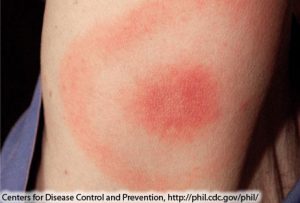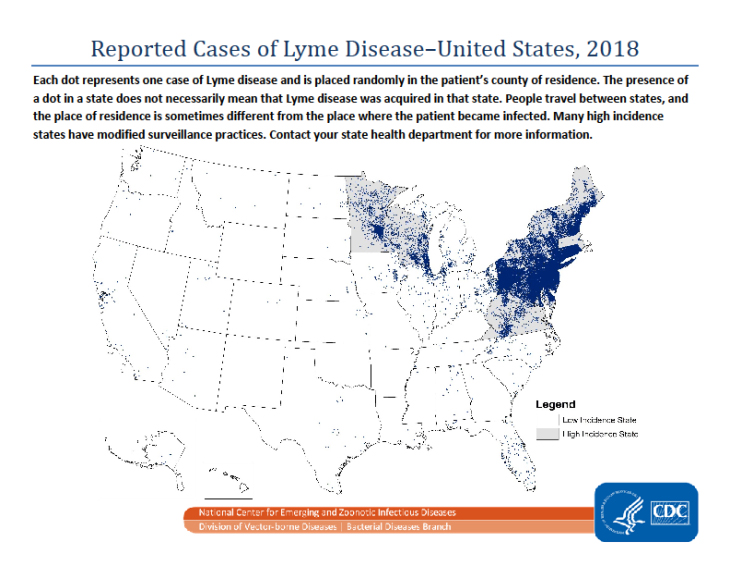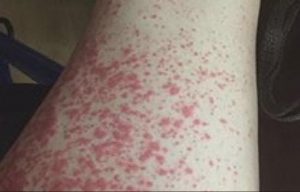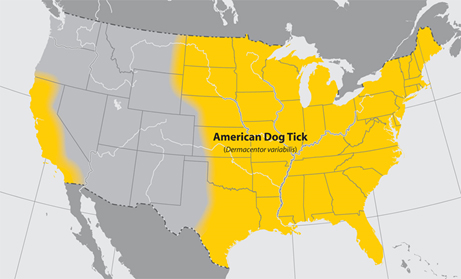Tick-Borne Illnesses
Lyme Disease
 Lyme disease is the most common vector-borne illness in the United States. It is estimated that 329,000 people contract Lyme disease annually in the US. Lyme disease is caused by Borrelia burgdorferi bacteria that are generally transmitted when infected blacklegged deer ticks bite humans. According to the CDC, in most cases, the tick must be attached for 36-48 hours or longer before the Lyme disease can be transmitted because the bacteria must travel from the tick’s gut through its mouthpiece and finally into the blood of the bite victim. Lyme disease has three stages: early localized, early disseminated and late disseminated. Dissemination is when the bacteria or virus has spread throughout the body or organs.
Lyme disease is the most common vector-borne illness in the United States. It is estimated that 329,000 people contract Lyme disease annually in the US. Lyme disease is caused by Borrelia burgdorferi bacteria that are generally transmitted when infected blacklegged deer ticks bite humans. According to the CDC, in most cases, the tick must be attached for 36-48 hours or longer before the Lyme disease can be transmitted because the bacteria must travel from the tick’s gut through its mouthpiece and finally into the blood of the bite victim. Lyme disease has three stages: early localized, early disseminated and late disseminated. Dissemination is when the bacteria or virus has spread throughout the body or organs.
Early localized infection is when the bacteria have recently entered the body. Commonly, an erythema migrans rash, known as “bull’s eye” rash, will appear at the site of the tick bite. The rash may appear within a few days to a month of the bite and may increase in size daily. However, some people who contract Lyme disease do not manifest the rash. Upon contracting Lyme, a person may experience fatigue, headaches, body aches, fever, and chills.
The early disseminated infection period is when the bacteria spread throughout the bloodstream. More bull’s eye rashes may appear throughout the body. The victim may experience joint and muscle pains, severe headaches, stiff neck, facial paralysis on one or both sides, numbness in hands or feet and extreme fatigue.
Late disseminated infection can occur after a few months if the disease is left untreated. The infected person will continue to experience symptoms from the previous stages and may develop more severe health issues such as arthritis, heart palpitations, insomnia, and neurological symptoms such as confusion or mental cloudiness.
If a tick bit you or you have signs such as the bulls-eye rash, you should visit a health care professional: the sooner treatment starts, the better. If possible, bring in the tick that bit you for testing.
The doctor may do an antibody test on you to see if your body has created antibodies to fight the Lyme infection. Many cases of Lyme disease are cured with a 2-4 week course of oral antibiotics.
The Borrelia burgdorferi bacteria that cause Lyme disease in humans can also cause Lyme disease in canines. Many dogs that are infected never show any signs. In other cases, it can take weeks or months for symptoms to appear in dogs. Since ticks can readily hide in the long fur of a canine, they sometimes go unnoticed. Symptoms of Lyme canines in canines can be joint pain, swelling, loss of appetite, lethargy, kidney issues, and fever.
Lyme disease can be hard to identify in dogs, so talk to your veterinarian if your dog in behaving differently from normal. The vet can perform blood tests if Lyme is suspected and observe the canine for physical signs of the disease. Treatment for Lyme disease usually includes a course of antibiotics.
Make sure you give your dog monthly tick medicine to help protect them from ticks-borne illnesses.

Rocky Mountain Spotted Fever (RMSF)
 Rocky Mountain spotted fever (RMSF) is a potentially deadly tick-borne illnesses found in the United States. Rickettsia rickettsii is the bacteria transmitted through by the bite of an infected tick. Types of ticks that can transmit RMSF are Rocky Mountain wood tick, brown dog tick and the American dog tick (which we have here in abundance on the east coast). An R. rickettsii bacterium damages the linings of the smallest blood vessels in the body and can cause them to form clots. As a result, RMSF can affect many systems in the body, such as respiratory, neurological, and digestive. Heart and kidney damage can ensue if the disease is left untreated.
Rocky Mountain spotted fever (RMSF) is a potentially deadly tick-borne illnesses found in the United States. Rickettsia rickettsii is the bacteria transmitted through by the bite of an infected tick. Types of ticks that can transmit RMSF are Rocky Mountain wood tick, brown dog tick and the American dog tick (which we have here in abundance on the east coast). An R. rickettsii bacterium damages the linings of the smallest blood vessels in the body and can cause them to form clots. As a result, RMSF can affect many systems in the body, such as respiratory, neurological, and digestive. Heart and kidney damage can ensue if the disease is left untreated.
Like so many other vector-borne illnesses, Rocky Mountain spotted fever signs and symptoms can mimic those of the flu or other sicknesses. Early symptoms may include fever, chills, headache, nausea, vomiting, stomach pain, muscle pain, loss of appetite, and rash. If left untreated, the disease can cause shortness of breath, rapid breathing, jaundice, severe abdominal pain, confusion, difficulty walking, seizures, coma, and in some cases, death.
A rash can occur after a week from the date of the initial tick bite. How the rash looks can be valuable in the diagnosis of RMSF as it is very different from others (such as the bull’s eye tick bite due to Lyme disease). The distinct rash usually starts with pink/red small non-itchy spots on the wrists and ankles and gradually spreads from those areas. The spots of the rash might seem like they have a redder pinpointed center due to the contained bleeding under the skin.
Sever cases of Rocky Mountain Fever can lead to lung failure, kidney failure, significant bleeding, and even brain damage. Therefore it is essential to see a doctor if you develop a rash or start to feel sick after a tick bite. Your healthcare provider will order blood tests and other lab work to help with the diagnosis of RMSF. The results of these tests can take weeks, so doctors start patients on antibiotics to combat the infection immediately.

Source: CDC – Cases Reported to CDC of Rocky Mountain Spotted Fever (U.S. in 2014)

Source: CDC – American Dog Tick’s Habitat in the U.S.
Ehrlichiosis
 Ehrlichiosis is caused by bacteria that are transmitted by the bite of an infected tick. It can be transmitted by a lone star tick, American dog tick or deer tick. The ehrlichiosis bacteria live inside an infected person’s (or animal’s) white blood cells. In humans, signs, and symptoms usually start to appear within a week of the initial tick bite and are often similar to flu symptoms.
Ehrlichiosis is caused by bacteria that are transmitted by the bite of an infected tick. It can be transmitted by a lone star tick, American dog tick or deer tick. The ehrlichiosis bacteria live inside an infected person’s (or animal’s) white blood cells. In humans, signs, and symptoms usually start to appear within a week of the initial tick bite and are often similar to flu symptoms.
Symptoms may include fever, chills, headaches, muscle aches, nausea, vomiting, and confusion. Sometimes an adult will manifest rashes, but this is most common in children. Since ehrlichiosis attacks a body’s white blood cells (the disease fighters) and the platelets (involved in blood clotting), it has the potential to cause severe symptoms such as damage to the brain and nervous system, respiratory failure, organ failure, uncontrolled bleeding, and death.
Ehrlichiosis is very common in dogs as they are an easy target for ticks. This bacterium, like in humans, infects and lives in the white blood cells of the canine host. In canines, it can take 1-3 weeks for them to show signs. If they do not fight the infection off by themselves, they can enter the acute phase. Acute phase symptoms include fever, lethargy, poor appetite, occasional lameness, abnormal bruising and bleeding, vomiting, and diarrhea.
Canines will often recover without treatment and enter into what is called the subclinical phase, in which they don’t show any symptoms. In this phase, the bacteria live inside the canine, but does not cause discomfort. Therefore, even if the bacteria are detected in the blood, the canine may live a happy, healthy life without any symptoms of the disease.
Unfortunately, some dogs enter the chronic phase, which can happen even after the disease has subsided for a time. The canine may experience weight loss, pale gums, abnormal bleeding, coughing, lameness, and neurological abnormalities. If you suspect ehrlichiosis in your canine, you should have them screened by your veterinarian. The vet will do some blood work and start your canine on a course of antibiotics if necessary.
Make sure you give you dog monthly flea and tick medicine to help prevent ticks from latching on to them! The oral medication is transmitted to the tick when they bite your dog; it kills the tick once ingested.
